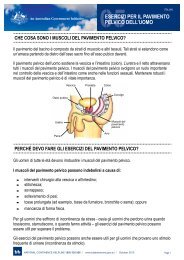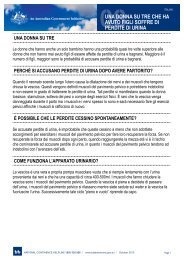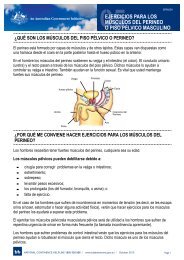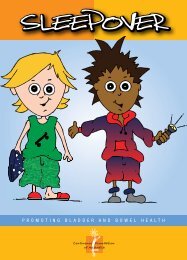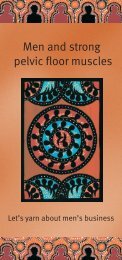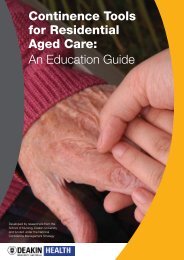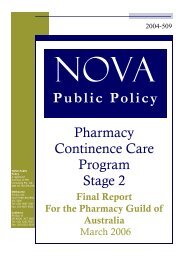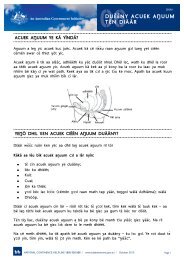Leaking urine: Prevalence and associated factors in Australian women
Leaking urine: Prevalence and associated factors in Australian women
Leaking urine: Prevalence and associated factors in Australian women
You also want an ePaper? Increase the reach of your titles
YUMPU automatically turns print PDFs into web optimized ePapers that Google loves.
<strong>Leak<strong>in</strong>g</strong> Ur<strong>in</strong>e: <strong>Prevalence</strong> <strong>and</strong> Associated<br />
Factors <strong>in</strong> <strong>Australian</strong> Women<br />
Paul<strong>in</strong>e Chiarelli, 1 Wendy Brown, 2 * <strong>and</strong> Patrick McElduff 3<br />
1 Faculty of Medic<strong>in</strong>e <strong>and</strong> Health Sciences, The University of Newcastle, NSW, Australia<br />
2 Research Institute for Gender <strong>and</strong> Health, The University of Newcastle, NSW, Australia<br />
3 Department of Statistics, The University of Newcastle, NSW, Australia<br />
The Women’s Health Australia project provided the opportunity to exam<strong>in</strong>e the prevalence<br />
of leak<strong>in</strong>g <strong>ur<strong>in</strong>e</strong> <strong>and</strong> <strong>associated</strong> variables <strong>in</strong> three large cohorts of <strong>Australian</strong> <strong>women</strong> 18–23<br />
years of age (“young” N � 14,761), 45–50 (“mid-age” N � 14,070), <strong>and</strong> 70–75 (“older”<br />
N � 12,893). The proportion of <strong>women</strong> report<strong>in</strong>g leak<strong>in</strong>g <strong>ur<strong>in</strong>e</strong> was 12.8% (95% CI:<br />
12.2–13.3), 36.1% (35.2– 37.0), <strong>and</strong> 35% (34.1– 35.9) <strong>in</strong> each of the three cohorts, respectively.<br />
Logistic regression analysis showed significant associations between leak<strong>in</strong>g <strong>ur<strong>in</strong>e</strong><br />
<strong>and</strong> parity <strong>in</strong> the young <strong>and</strong> mid-age <strong>women</strong>, <strong>and</strong> between leak<strong>in</strong>g <strong>ur<strong>in</strong>e</strong> <strong>and</strong> constipation,<br />
other bowel symptoms, body mass <strong>in</strong>dex, <strong>and</strong> <strong>ur<strong>in</strong>e</strong> that burns or st<strong>in</strong>gs <strong>in</strong> all three groups.<br />
In the mid-age <strong>and</strong> older cohorts, <strong>women</strong> who reported hav<strong>in</strong>g both hysterectomy <strong>and</strong><br />
prolapse repair, or prolapse repair alone, were also more likely to report leak<strong>in</strong>g <strong>ur<strong>in</strong>e</strong>.<br />
Lower scores on the physical <strong>and</strong> mental component summary scores of the medical outcomes<br />
survey short form (36 items) questionnaire suggest lower quality of life among<br />
<strong>women</strong> who report leak<strong>in</strong>g <strong>ur<strong>in</strong>e</strong>, compared with those who do not. Neurourol. Urodynam.<br />
18:567–577, 1999. © 1999 Wiley-Liss, Inc.<br />
Key words: female ur<strong>in</strong>ary <strong>in</strong>cont<strong>in</strong>ence; parity; gynaecological surgery; constipation<br />
INTRODUCTION<br />
Ur<strong>in</strong>ary <strong>in</strong>cont<strong>in</strong>ence (UI) is morbid [Grimby et al., 1993], costly [Fonda, 1992],<br />
<strong>and</strong> progressive [Ousl<strong>and</strong>er, 1990] <strong>and</strong> affects <strong>women</strong> seven to eight times more often<br />
than men [Millard, 1985]. It is often presumed to be a condition experienced only <strong>in</strong><br />
old age; one study has estimated that 50% of the 75,000 residents <strong>in</strong> <strong>Australian</strong><br />
nurs<strong>in</strong>g homes (70% of whom are <strong>women</strong>) are “wet” [Millard, 1996]. Indeed, several<br />
epidemiological studies have shown a significant association between UI <strong>and</strong> older<br />
age [Mol<strong>and</strong>er et al., 1990; Burgio et al., 1991; Milsom et al,. 1993]. However, studies<br />
of UI <strong>in</strong> <strong>women</strong> across all age groups have estimated the prevalence to be between<br />
25% [Foldspang et al., 1992] <strong>and</strong> 45% [Yarnell et al., 1981], <strong>and</strong> one 1985 study of<br />
1,256 community dwell<strong>in</strong>g adults has estimated the prevalence among <strong>Australian</strong><br />
<strong>women</strong> over 10 years of age to be 34% [Millard, 1985].<br />
*Correspondence to: Dr. Wendy J. Brown, Research Institute for Gender <strong>and</strong> Health, The University of<br />
Newcastle, Callaghan, NSW 2308, Australia. E-mail: whwjb@cc.newcastle.edu.au<br />
Received 25 May 1998; Accepted 20 April 1999<br />
© 1999 Wiley-Liss, Inc.<br />
PROD #1062<br />
Neurourology <strong>and</strong> Urodynamics 18:567–577 (1999)
568 Chiarelli et al.<br />
Parity is commonly <strong>associated</strong> with UI [Thomas <strong>and</strong> Plymat, 1980; Jolleys,<br />
1988; Foldspang et al., 1992; Milsom et al., 1993]. Vag<strong>in</strong>al delivery has been shown<br />
to <strong>in</strong>duce stretch<strong>in</strong>g <strong>in</strong>jury to several structures with<strong>in</strong> the lower part of the bony<br />
pelvis as well as to the pelvic floor muscles, nerves, <strong>and</strong> connective tissues [Snooks<br />
et al., 1984, 1985b; Swash, 1990]. In many cases, the resultant trauma may lead to<br />
poor support of the pelvic organs. Further <strong>in</strong>sult to the weakened pelvic floor structures<br />
can occur <strong>in</strong> time by way of <strong>in</strong>creases <strong>in</strong> abdom<strong>in</strong>al pressure that accompany<br />
such conditions as constipation [Lawrence <strong>and</strong> Bannister, 1985; Laycock <strong>and</strong> Jerwood,<br />
1991], chronic cough<strong>in</strong>g or sneez<strong>in</strong>g [Constant<strong>in</strong>ou <strong>and</strong> Gowan, 1982; Laycock<br />
<strong>and</strong> Jerwood, 1991], <strong>and</strong> obesity [Koelbl <strong>and</strong> Riss, 1987; Wilkie, 1987]. In time these<br />
conditions are thought to lead to pelvic organ prolapse <strong>and</strong>/or ur<strong>in</strong>ary <strong>in</strong>cont<strong>in</strong>ence<br />
[Snooks et al., 1985a; Koelbl <strong>and</strong> Riss, 1987; Spence-Jones et al., 1994]. Other studies<br />
have suggested an association between ur<strong>in</strong>ary <strong>in</strong>cont<strong>in</strong>ence <strong>and</strong> other dysfunctional<br />
bowel symptoms [Coates et al., 1997; Cukier et al., 1997].<br />
A variety of other <strong>factors</strong> has also been shown to be <strong>associated</strong> with female UI.<br />
These <strong>in</strong>clude hormonal status, surgery, ur<strong>in</strong>ary tract disorders <strong>and</strong> hereditary <strong>factors</strong>.<br />
While ur<strong>in</strong>ary <strong>in</strong>cont<strong>in</strong>ence is known to be <strong>associated</strong> with perimenopause, a study of<br />
3,114 Danish <strong>women</strong> has found that surgical procedures contribute more strongly than<br />
menopause status to the experience of UI <strong>in</strong> middle aged <strong>women</strong> [Foldspang <strong>and</strong><br />
Mommsen, 1994]. Significant associations between UI <strong>and</strong> urogynecological surgery<br />
have also been reported by researchers <strong>in</strong> the United States <strong>and</strong> the United K<strong>in</strong>gdom<br />
[Parys et al., 1989; Benson <strong>and</strong> McLellan 1993; Mommsen et al., 1993].<br />
UI is also markedly <strong>in</strong>creased dur<strong>in</strong>g acute ur<strong>in</strong>ary tract <strong>in</strong>fection (UTI) <strong>and</strong><br />
dur<strong>in</strong>g pregnancy. In another study of Danish <strong>women</strong>, Mommsen found that <strong>women</strong><br />
with UTI are almost six times more likely to experience <strong>in</strong>cont<strong>in</strong>ence [Mommsen et<br />
al., 1994], <strong>and</strong> Chiarelli has reported the prevalence of <strong>in</strong>cont<strong>in</strong>ence <strong>in</strong> <strong>Australian</strong><br />
<strong>women</strong> dur<strong>in</strong>g pregnancy to be 64% [Chiarelli <strong>and</strong> Campbell, 1997].<br />
UI may also be <strong>associated</strong> with hereditary <strong>factors</strong>. Studies of the prevalence of<br />
UI show a significant relationship between <strong>in</strong>cont<strong>in</strong>ent <strong>women</strong> <strong>and</strong> their first degree<br />
female relatives [Mushkat et al., 1996], which may be expla<strong>in</strong>ed by a constitutional<br />
or genetic weakness <strong>in</strong> the collagen of <strong>women</strong> with bladder neck prolapse <strong>and</strong> stress<br />
<strong>in</strong>cont<strong>in</strong>ence of <strong>ur<strong>in</strong>e</strong> [Sayer, 1994].<br />
The <strong>Australian</strong> Longitud<strong>in</strong>al Study on Women’s Health [now known as the<br />
Women’s Health Australia (WHA) project] provided an opportunity to determ<strong>in</strong>e the<br />
prevalence of leak<strong>in</strong>g <strong>ur<strong>in</strong>e</strong> <strong>and</strong> <strong>associated</strong> <strong>factors</strong> <strong>in</strong> <strong>Australian</strong> <strong>women</strong>. The aims of<br />
this study were to exam<strong>in</strong>e the prevalence of the self-report of leak<strong>in</strong>g <strong>ur<strong>in</strong>e</strong> <strong>in</strong> young,<br />
mid-age, <strong>and</strong> older <strong>Australian</strong> <strong>women</strong>; to assess the associations between leak<strong>in</strong>g<br />
<strong>ur<strong>in</strong>e</strong> <strong>and</strong> parity, constipation <strong>and</strong> other bowel problems, body mass <strong>in</strong>dex (BMI),<br />
symptoms of UTI, <strong>and</strong> gynaecological surgery; <strong>and</strong> to explore differences <strong>in</strong> health<br />
related quality of life <strong>in</strong> <strong>women</strong> who do <strong>and</strong> do not report leak<strong>in</strong>g <strong>ur<strong>in</strong>e</strong>.<br />
On the basis of previous research, it was hypothesised that the prevalence of<br />
leak<strong>in</strong>g <strong>ur<strong>in</strong>e</strong> would <strong>in</strong>crease with age <strong>and</strong> that parity, constipation, or other bowel<br />
problems, high BMI, gynaecological surgery, <strong>and</strong> symptoms of UTI (<strong>ur<strong>in</strong>e</strong> that burns<br />
or st<strong>in</strong>gs) would be <strong>associated</strong> with leak<strong>in</strong>g <strong>ur<strong>in</strong>e</strong>. It was further hypothesised that the<br />
quality of life of <strong>women</strong> who report leak<strong>in</strong>g <strong>ur<strong>in</strong>e</strong> would be lower than that of other<br />
<strong>women</strong>.
MATERIALS AND METHODS<br />
The Women’s Health Australia Project<br />
The Women’s Health Australia project aims to exam<strong>in</strong>e the relationships between<br />
biological, psychological, social <strong>and</strong> lifestyle <strong>factors</strong>, <strong>and</strong> <strong>women</strong>’s physical<br />
<strong>and</strong> emotional health <strong>and</strong> the use of <strong>and</strong> satisfaction with health care services. The<br />
project <strong>in</strong>volves three cohorts of <strong>women</strong> who were young (18–23 years), mid-age<br />
(45–50 years), or older (70–75 years) at the time of the basel<strong>in</strong>e survey. The <strong>women</strong><br />
were selected r<strong>and</strong>omly from the national health <strong>in</strong>surance (Medicare) database,<br />
which <strong>in</strong>cludes all <strong>women</strong> who are resident <strong>in</strong> Australia, <strong>in</strong>clud<strong>in</strong>g <strong>women</strong> from<br />
m<strong>in</strong>ority ethnic groups as well as <strong>women</strong> refugees. Because there is a dearth of<br />
<strong>in</strong>formation about <strong>women</strong> who live outside the metropolitan areas, <strong>women</strong> who live<br />
<strong>in</strong> rural <strong>and</strong> remote areas of Australia were over sampled. Details of the recruitment<br />
methods have been described elsewhere [Brown et al., 1998].<br />
Participants<br />
Dur<strong>in</strong>g 1996, 14,761 young <strong>women</strong> (48% of those <strong>in</strong>vited to participate), 14,070<br />
mid-age aged <strong>women</strong> (54%), <strong>and</strong> 12,893 older <strong>women</strong> (41%) completed the basel<strong>in</strong>e<br />
surveys for the WHA project. The participants <strong>in</strong>clude <strong>women</strong> from all walks of life,<br />
liv<strong>in</strong>g <strong>in</strong> every State <strong>and</strong> Territory of Australia. They are broadly representative of the<br />
female population of these age groups, but with over-representation of <strong>women</strong> with<br />
post-school education [Brown et al., 1998].<br />
The Questionnaire <strong>and</strong> Measures<br />
<strong>Leak<strong>in</strong>g</strong> Ur<strong>in</strong>e <strong>in</strong> <strong>Australian</strong> Women 569<br />
The basel<strong>in</strong>e questionnaire consisted of 252, 285, <strong>and</strong> 260 items, respectively,<br />
for the young, mid-age, <strong>and</strong> older cohorts. One of the items asked whether <strong>women</strong> had<br />
experienced leak<strong>in</strong>g <strong>ur<strong>in</strong>e</strong> <strong>in</strong> the last year. Response options were never, rarely,<br />
sometimes, or often. Responses to this question (those answer<strong>in</strong>g rarely, sometimes,<br />
often) were used to estimate the prevalence of leak<strong>in</strong>g <strong>ur<strong>in</strong>e</strong> <strong>in</strong> each cohort.<br />
Questions about other symptoms, conditions, surgical conditions, <strong>and</strong> life events<br />
varied for each cohort <strong>and</strong> <strong>in</strong>cluded the follow<strong>in</strong>g: all <strong>women</strong>—childbirth (number of<br />
times); upper respiratory tract symptoms <strong>and</strong> conditions (allergies/hay fever/s<strong>in</strong>usitis,<br />
asthma, breath<strong>in</strong>g difficulties, bronchitis/emphysema); other symptoms that can affect<br />
the pelvic floor (constipation, other bowel problems, body mass <strong>in</strong>dex); <strong>and</strong> symptoms<br />
or conditions that can impact on bladder control (<strong>ur<strong>in</strong>e</strong> that burns or st<strong>in</strong>gs, diabetes);<br />
mid age <strong>and</strong> older <strong>women</strong>—gynaecological surgery (hysterectomy, removal of both<br />
ovaries, repair of prolapse of the uterus, bladder or bowel); <strong>and</strong> symptoms or conditions<br />
that can affect on bladder control (go<strong>in</strong>g through menopause, currently tak<strong>in</strong>g<br />
hormone replacement therapy (HRT), number of years on HRT, tak<strong>in</strong>g drugs for<br />
“nerves” or to help with sleep<strong>in</strong>g difficulties, stroke).<br />
Questions about symptoms were prefixed by “In the last twelve months have<br />
you experienced . . . ?,” while questions about conditions <strong>and</strong> procedures were prefixed<br />
by “Have you ever been told by a doctor that you have ...?”or“Have you ever<br />
had . . . ?.” Questions about medications were prefixed by “In the past four weeks<br />
have you taken ...?.”<br />
The medical outcome survey short form health questionnaire (SF-36) [Ware,<br />
1994] was used to assess general physical <strong>and</strong> mental health <strong>and</strong> well-be<strong>in</strong>g <strong>in</strong> each
570 Chiarelli et al.<br />
group. The physical <strong>and</strong> mental component summary scores (PCS <strong>and</strong> MCS) were<br />
calculated us<strong>in</strong>g the WHA cohort adjustment <strong>factors</strong> [Mishra <strong>and</strong> Schofield, 1998].<br />
Data Analysis<br />
Descriptive statistics, ma<strong>in</strong>ly proportions <strong>and</strong> 95% confidence <strong>in</strong>tervals, were<br />
calculated for self report of leak<strong>in</strong>g <strong>ur<strong>in</strong>e</strong> <strong>in</strong> the three groups. Miss<strong>in</strong>g data were<br />
<strong>in</strong>cluded <strong>in</strong> the “not leak<strong>in</strong>g” category. For each group univariate analyses were used<br />
to explore associations between cl<strong>in</strong>ically plausible variables such as parity, symptoms,<br />
procedures, medications, <strong>and</strong> leak<strong>in</strong>g <strong>ur<strong>in</strong>e</strong>. Variables that were significantly<br />
<strong>associated</strong> with leak<strong>in</strong>g <strong>ur<strong>in</strong>e</strong> were then entered <strong>in</strong>to a logistic regression model to<br />
further exam<strong>in</strong>e the strength of the associations between leak<strong>in</strong>g <strong>ur<strong>in</strong>e</strong> <strong>and</strong> each of the<br />
variables, while controll<strong>in</strong>g for the others. Miss<strong>in</strong>g data were not <strong>in</strong>cluded. For the<br />
younger cohort the variables entered <strong>in</strong>to the model were parity, constipation, other<br />
bowel problems, body mass <strong>in</strong>dex, <strong>and</strong> <strong>ur<strong>in</strong>e</strong> that burns or st<strong>in</strong>gs. For the mid-age <strong>and</strong><br />
older cohorts gynaecological surgery (<strong>in</strong>clud<strong>in</strong>g removal of both ovaries, hysterectomy,<br />
<strong>and</strong> repair of prolapsed vag<strong>in</strong>a, bladder, or bowel) was also <strong>in</strong>cluded. Adjusted<br />
BMI was calculated from self report of height <strong>and</strong> weight, corrected follow<strong>in</strong>g the<br />
method of Waters [1993]. Pairwise comparisons of the adjusted mean PCS <strong>and</strong> MCS<br />
were then computed for <strong>women</strong> <strong>in</strong> each cohort who reported leak<strong>in</strong>g <strong>ur<strong>in</strong>e</strong> <strong>and</strong> those<br />
who did not.<br />
RESULTS<br />
The prevalence of leak<strong>in</strong>g <strong>ur<strong>in</strong>e</strong> <strong>in</strong> the young, mid-age <strong>and</strong> older <strong>women</strong> was<br />
estimated to be 12.8% (CI: 12.2–13.3), 36.1% (CI: 35.2–37.0), <strong>and</strong> 35% (CI: 34.1–<br />
35.9), respectively.<br />
Associations between self-report of leak<strong>in</strong>g <strong>ur<strong>in</strong>e</strong> <strong>in</strong> <strong>Australian</strong> <strong>women</strong> <strong>and</strong><br />
other reported symptoms, conditions, <strong>and</strong> life events <strong>in</strong> the younger cohort, the<br />
mid-age cohort, <strong>and</strong> the older cohort respectively are shown <strong>in</strong> Tables I–III.<br />
While there was a significant association between leak<strong>in</strong>g <strong>ur<strong>in</strong>e</strong> <strong>and</strong> parity <strong>in</strong> the<br />
younger group, this association was lessened by the impact of other conditions such<br />
as surgery <strong>in</strong> the older groups. In the young cohort, <strong>women</strong> with children <strong>and</strong> those<br />
who reported sometimes or often hav<strong>in</strong>g <strong>ur<strong>in</strong>e</strong> that burns or st<strong>in</strong>gs were most likely<br />
to report leak<strong>in</strong>g <strong>ur<strong>in</strong>e</strong>. There was also a strong association between constipation <strong>and</strong><br />
leak<strong>in</strong>g <strong>ur<strong>in</strong>e</strong> (Table I).<br />
In the mid-age cohort, <strong>women</strong> who reported <strong>ur<strong>in</strong>e</strong> that burns or st<strong>in</strong>gs, constipation,<br />
<strong>and</strong> those with high BMI were most likely to experience leak<strong>in</strong>g <strong>ur<strong>in</strong>e</strong>. While<br />
hysterectomy alone was <strong>associated</strong> with a lower odds ratio for leak<strong>in</strong>g <strong>ur<strong>in</strong>e</strong>, <strong>women</strong><br />
who reported prolapse repair either alone or with hysterectomy were more likely to<br />
leak <strong>ur<strong>in</strong>e</strong> (Table II).<br />
In the older cohort, there was no effect for parity but all forms of surgery except<br />
solely hysterectomy were <strong>associated</strong> with leak<strong>in</strong>g <strong>ur<strong>in</strong>e</strong>. Once aga<strong>in</strong>, <strong>women</strong> with the<br />
highest BMI <strong>and</strong> those report<strong>in</strong>g <strong>ur<strong>in</strong>e</strong> that burns or st<strong>in</strong>gs <strong>and</strong> constipation were most<br />
likely to report leak<strong>in</strong>g <strong>ur<strong>in</strong>e</strong> (Table III).<br />
Adjusted mean SF-36 physical <strong>and</strong> mental component summary scores for each<br />
group are shown <strong>in</strong> Table IV. While both PCS <strong>and</strong> MCS scores were significantly
TABLE I. Adjusted Odds Ratios for Variables Associated With <strong>Leak<strong>in</strong>g</strong> Ur<strong>in</strong>e <strong>in</strong> the<br />
Young Cohort<br />
Variable<br />
lower <strong>in</strong> all three age groups for <strong>women</strong> who reported leak<strong>in</strong>g <strong>ur<strong>in</strong>e</strong>, the greatest<br />
differences were seen for MCS scores <strong>in</strong> the young <strong>and</strong> mid-age <strong>women</strong> (Table IV).<br />
DISCUSSION<br />
Never (N)<br />
Leak <strong>ur<strong>in</strong>e</strong><br />
Rarely,<br />
sometimes, often<br />
(N)<br />
Adjusted a<br />
Odds ratio (95% CI)<br />
Parity<br />
Never 11,460 1,535 1.00<br />
Once 773 290 2.82 (2.37–3.35)<br />
Twice 203 77 2.59 (1.86–3.61)<br />
Three or more 39 25 4.84 (2.54–9.20)<br />
Constipation<br />
Never 8,207 698 1.00<br />
Rarely 2,979 697 2.13 (1.87–2.42)<br />
Sometimes 1,129 412 2.86 (2.43–3.36)<br />
Often 368 150 2.66 (2.07–3.40)<br />
Other bowel problems<br />
Never 11,308 1,462 1.00<br />
Rarely 738 268 1.97 (1.65–2.35)<br />
Sometimes 426 142 1.50 (1.18–1.89)<br />
Often 215 84 1.82 (1.33–2.48)<br />
BMI adjusted<br />
Underweight
572 Chiarelli et al.<br />
TABLE II. Adjusted Odds Ratios for Variables Associated With <strong>Leak<strong>in</strong>g</strong> Ur<strong>in</strong>e <strong>in</strong> the<br />
Mid-Age Cohort<br />
Variable<br />
Never (N)<br />
Leak <strong>ur<strong>in</strong>e</strong><br />
Rarely,<br />
sometimes, often<br />
(N)<br />
Adjusted a<br />
Odds ratio (95% CI)<br />
Parity<br />
Never 803 277 1.00<br />
Once 751 405 1.58 (1.29–1.93)<br />
Twice 3,252 1,828 1.66 (1.41–1.95)<br />
Three or more 3,572 2,320 1.81 (1.54–2.12)<br />
BMI adjusted:<br />
Underweight
TABLE III. Adjusted Odds Ratios for Variables Associated With <strong>Leak<strong>in</strong>g</strong> Ur<strong>in</strong>e <strong>in</strong> the<br />
Older Cohort<br />
Variable<br />
Never (N)<br />
Leak <strong>ur<strong>in</strong>e</strong><br />
Rarely,<br />
sometimes, often<br />
(N)<br />
Adjusted a<br />
Odds ratio (95% CI)<br />
Parity<br />
Never 726 301 1.00<br />
Once 723 302 0.88 (0.71–1.10)<br />
Twice 1,792 987 1.14 (0.96–1.36)<br />
Three or more 4,278 2,493 1.16 (0.98–1.36)<br />
Constipation<br />
Never 4,758 1,355 1.00<br />
Rarely 1,232 1,227 2.67 (2.38–2.99)<br />
Sometimes 1,206 1,000 2.05 (1.82–2.31)<br />
Often 475 476 2.21 (1.87–2.61)<br />
Other bowel problems<br />
Never 6,292 2,636 1.00<br />
Rarely 509 542 1.48 (1.28–1.72)<br />
Sometimes 536 503 1.39 (1.20–1.62)<br />
Often 240 269 1.51 (1.22–1.87)<br />
BMI adjusted<br />
Underweight
574 Chiarelli et al.<br />
TABLE IV. Means <strong>and</strong> 95% CI for SF-36 Physical <strong>and</strong> Mental Component Summary Scores <strong>in</strong><br />
Women Who Did <strong>and</strong> Did Not Report <strong>Leak<strong>in</strong>g</strong> Ur<strong>in</strong>e <strong>in</strong> Each Group<br />
Leak <strong>ur<strong>in</strong>e</strong><br />
Young <strong>women</strong><br />
(18–23)<br />
N � 14,328<br />
Mid-age <strong>women</strong><br />
(45–50)<br />
N � 13,022<br />
Older <strong>women</strong><br />
(70–75)<br />
N � 10,464<br />
Physical component<br />
summary score Rarely/sometimes/often 46.5 48.0 48.7<br />
(46.01–46.93) (47.74–48.32) (48.43–49.02)<br />
Never 49.1 50.4 52.2<br />
(48.99–49.28) (50.25–50.62) (51.94–52.37)<br />
Mental component<br />
summary score Rarely/sometimes/often 40.7 44.7 49.7<br />
(40.07–41.23) (44.37–45.08) (49.38–50.01)<br />
Never 46.3 48.5 52.6<br />
(46.05–46.48) (48.19–48.70) (52.30–52.76)<br />
<strong>ur<strong>in</strong>e</strong>, <strong>in</strong> either the mid-age or older <strong>women</strong>. Neither current use of HRT nor duration<br />
of use were <strong>associated</strong> with leak<strong>in</strong>g <strong>ur<strong>in</strong>e</strong>, <strong>and</strong> add<strong>in</strong>g HRT to the logistic regression<br />
made little difference to the model.<br />
The strong association between leak<strong>in</strong>g <strong>ur<strong>in</strong>e</strong> <strong>and</strong> reports of “<strong>ur<strong>in</strong>e</strong> that burns or<br />
st<strong>in</strong>gs” was not surpris<strong>in</strong>g. S<strong>in</strong>ce the association was significant for each cohort,<br />
general practitioners might f<strong>in</strong>d treatment of UTI an opportune time to raise the issue<br />
of leak<strong>in</strong>g <strong>ur<strong>in</strong>e</strong> with their patients, who may have previously been too embarrassed<br />
to mention that they are experienc<strong>in</strong>g ur<strong>in</strong>ary <strong>in</strong>cont<strong>in</strong>ence. Similarly, for <strong>women</strong> who<br />
do raise the issue of leak<strong>in</strong>g <strong>ur<strong>in</strong>e</strong>, general practitioners might f<strong>in</strong>d this an opportune<br />
time to ask about constipation, which was also strongly <strong>associated</strong> with leak<strong>in</strong>g <strong>ur<strong>in</strong>e</strong><br />
<strong>in</strong> each age group <strong>in</strong> this study. Repeated “stra<strong>in</strong><strong>in</strong>g at stool” is thought to weaken<br />
pelvic floor muscles <strong>and</strong> ligaments <strong>and</strong> exacerbate leakage symptoms [Lawrence <strong>and</strong><br />
Bannister, 1985; Laycock <strong>and</strong> Jerwood, 1991]. Prevention of constipation, for example,<br />
by <strong>in</strong>creas<strong>in</strong>g dietary fibre, fluid <strong>in</strong>take, <strong>and</strong> physical activity, may therefore<br />
also help to alleviate the symptoms of leak<strong>in</strong>g <strong>ur<strong>in</strong>e</strong>.<br />
In this study there was a direct relationship between leak<strong>in</strong>g <strong>ur<strong>in</strong>e</strong> <strong>and</strong> BMI.<br />
Other researchers have suggested that <strong>in</strong>creas<strong>in</strong>g pressure on the pelvic floor from<br />
excess weight exacerbates leakage [Koelbl <strong>and</strong> Riss, 1987; Wilkie, 1987]. In light of<br />
this, health professionals who are encourag<strong>in</strong>g <strong>women</strong> to make changes to dietary <strong>and</strong><br />
activity patterns may be able to add the motivat<strong>in</strong>g “reward” of decreased leakage as<br />
an additional benefit of weight reduction strategies. It is also possible however that<br />
leak<strong>in</strong>g <strong>ur<strong>in</strong>e</strong> <strong>in</strong> the months <strong>and</strong> years follow<strong>in</strong>g childbirth may be a barrier to<br />
participation <strong>in</strong> some forms of physical activity, thus <strong>in</strong>directly contribut<strong>in</strong>g to the<br />
problem of overweight <strong>and</strong> obesity <strong>in</strong> mid-age <strong>women</strong>.<br />
Researchers from the UK have correlated quality of life assessments us<strong>in</strong>g the<br />
SF-36 with urodynamic diagnosis of ur<strong>in</strong>ary <strong>in</strong>cont<strong>in</strong>ence <strong>in</strong> <strong>women</strong> <strong>and</strong> concluded<br />
that a number of specific ur<strong>in</strong>ary symptoms <strong>and</strong> urodynamic features are <strong>associated</strong><br />
with SF-36 scores [Kelleher et al., 1994; Khullar et al., 1995]. While the lower PCS<br />
<strong>and</strong> MCS scores for <strong>women</strong> who reported leak<strong>in</strong>g <strong>ur<strong>in</strong>e</strong> <strong>in</strong> the present study <strong>in</strong>dicate<br />
an association between well be<strong>in</strong>g <strong>and</strong> leak<strong>in</strong>g <strong>ur<strong>in</strong>e</strong>, these f<strong>in</strong>d<strong>in</strong>gs do not imply a<br />
direct casual relationship. There are likely to be many confound<strong>in</strong>g <strong>factors</strong>. For<br />
example, <strong>in</strong> the young cohort, 9.6% of the <strong>women</strong> had one or more children. Of these,<br />
35.6% were s<strong>in</strong>gle parents, <strong>and</strong> <strong>in</strong> general these young s<strong>in</strong>gle mothers reported very
high levels of stress <strong>and</strong> had low MCS scores. The f<strong>in</strong>d<strong>in</strong>gs may therefore reflect the<br />
fact that some of the young <strong>women</strong> with low MCS scores may have had weakened<br />
pelvic floor muscles because of recent childbirth <strong>and</strong> would therefore be more likely<br />
to experience leak<strong>in</strong>g <strong>ur<strong>in</strong>e</strong> [Viktrup et al., 1992]. It could also be argued that chronic<br />
problems such as diabetes <strong>and</strong> stroke, which may cause leak<strong>in</strong>g <strong>ur<strong>in</strong>e</strong> [Sotolongo,<br />
1994], might underlie differences <strong>in</strong> the SF-36 scores between those older <strong>women</strong><br />
who reported leak<strong>in</strong>g <strong>and</strong> those who did not. However, <strong>in</strong>clusion of these chronic<br />
illnesses <strong>in</strong> the model for the older <strong>women</strong>, did not improve the model <strong>and</strong> there was<br />
no significant association between leak<strong>in</strong>g <strong>ur<strong>in</strong>e</strong> <strong>and</strong> these problems.<br />
While many studies have looked at the efficacy of treatment protocols for cur<strong>in</strong>g<br />
or improv<strong>in</strong>g ur<strong>in</strong>ary <strong>in</strong>cont<strong>in</strong>ence once it has manifested itself, no studies have<br />
explored the efficacy of cont<strong>in</strong>ence promotion before <strong>in</strong>cont<strong>in</strong>ence is experienced. In<br />
view of the associations shown here between leak<strong>in</strong>g <strong>ur<strong>in</strong>e</strong> <strong>and</strong> parity <strong>in</strong> the young<br />
<strong>women</strong>, it would seem appropriate to explore opportunities for cont<strong>in</strong>ence promotion<br />
with young <strong>women</strong> when they present for pregnancy care. Conservative <strong>in</strong>tervention<br />
at this stage may have multiple benefits <strong>in</strong> terms of prevent<strong>in</strong>g <strong>in</strong>cont<strong>in</strong>ence, constipation,<br />
<strong>and</strong> possibly prolapse <strong>in</strong> later years. In view of the high prevalence of leak<strong>in</strong>g<br />
<strong>ur<strong>in</strong>e</strong> among <strong>women</strong> of all ages, <strong>and</strong> its likely physical <strong>and</strong> social sequelae (which<br />
<strong>in</strong>clude the need for nurs<strong>in</strong>g home care <strong>in</strong> old age), it is clear that there is now a need<br />
for more promotion <strong>and</strong> prevention strategies to be trialed <strong>and</strong> evaluated.<br />
ACKNOWLEDGMENTS<br />
The <strong>Australian</strong> Longitud<strong>in</strong>al Study on Women’s Health is funded by the (<strong>Australian</strong>)<br />
Commonwealth Department of Health <strong>and</strong> Family Services. The project was<br />
conceived <strong>and</strong> developed by groups of <strong>in</strong>ter-discipl<strong>in</strong>ary researchers at the Universities<br />
of Newcastle <strong>and</strong> Queensl<strong>and</strong>, <strong>and</strong> the contribution of all members of the research<br />
team at the University of Newcastle, particularly the research assistants Joy Goldsworthy<br />
<strong>and</strong> Lyn Adamson, <strong>and</strong> data manager Jean Ball, is gratefully acknowledged.<br />
We would like to thank all the participants who contributed to the basel<strong>in</strong>e surveys,<br />
<strong>and</strong> we are grateful to Kimberley-Clarke Pty, Ltd. for their support of this work.<br />
REFERENCES<br />
<strong>Leak<strong>in</strong>g</strong> Ur<strong>in</strong>e <strong>in</strong> <strong>Australian</strong> Women 575<br />
Benson J, McLellan E. 1993. The effect of vag<strong>in</strong>al dissection on the pudendal nerve. Obstet Gynecol<br />
82:387–389.<br />
Brown WJ, Bryson L, Byles J, Dobson AJ, Lee C, Mishra G, Schofield M. 1998. Women’s Health<br />
Australia: Recruitment for a national longitud<strong>in</strong>al cohort study. Women Health 28:23–40.<br />
Burgio KL, Matthews KA, Engel BT. 1991. <strong>Prevalence</strong>, <strong>in</strong>cidence <strong>and</strong> correlates of ur<strong>in</strong>ary <strong>in</strong>cont<strong>in</strong>ence<br />
<strong>in</strong> healthy middle aged <strong>women</strong>. J Urol 146:1255–1259.<br />
Chiarelli P, Campbell E. 1997. Incont<strong>in</strong>ence dur<strong>in</strong>g pregnancy: prevalence <strong>and</strong> opportunities for cont<strong>in</strong>ence<br />
promotion. Aust NZ J Obstet Gynaecol 37:66–73.<br />
Coates KW, Weldner AC, Cundiff JW, Elser D, Bump RC. 1997. Dysfunctional bowel symptoms <strong>in</strong><br />
<strong>women</strong> with ur<strong>in</strong>ary <strong>in</strong>cont<strong>in</strong>ence <strong>and</strong> pelvic organ prolapse. 18 th Annual Scientific Meet<strong>in</strong>g of the<br />
American Urogynecologic Society. Tucson, AZ: Spr<strong>in</strong>ger.<br />
Constant<strong>in</strong>ou CE, Gowan DE. 1982. Spatial distribution <strong>and</strong> tim<strong>in</strong>g of transmitted <strong>and</strong> reflexly generated<br />
urethral pressures <strong>in</strong> healthy <strong>women</strong>. J Urol 127:964.<br />
Cukier JM, Cort<strong>in</strong>a-Borja M, Brad<strong>in</strong>g AF. 1997. A case-control study to exam<strong>in</strong>e any association between<br />
ideopathic detrusor <strong>in</strong>stability <strong>and</strong> gastro<strong>in</strong>test<strong>in</strong>al tract disorder, <strong>and</strong> between irritable bowel syndrome<br />
<strong>and</strong> ur<strong>in</strong>ary tract disorder. Br J Urol 79:865–878.
576 Chiarelli et al.<br />
Foldspang, A, Mommsen S, Lam GW, Elv<strong>in</strong>g L. 1992. Parity as a correlate of adult female ur<strong>in</strong>ary<br />
<strong>in</strong>cont<strong>in</strong>ence prevalence. J Epidemiol Comm Health 46:595–600.<br />
Foldspang A, Mommsen S. 1994. The menopause <strong>and</strong> ur<strong>in</strong>ary <strong>in</strong>cont<strong>in</strong>ence. Int Urogynecol J Pelvic Floor<br />
Dysfunct 5:195–201.<br />
Fonda D. 1992. The billion dollar question: can <strong>in</strong>cont<strong>in</strong>ence be reduced <strong>in</strong> nurs<strong>in</strong>g homes? Med J Aus<br />
156:6–7.<br />
Grimby A, Milsom I, Mol<strong>and</strong>er U, Wiklund I, Ekelund P. 1993. The <strong>in</strong>fluence of ur<strong>in</strong>ary <strong>in</strong>cont<strong>in</strong>ence on<br />
the quality of life of elderly <strong>women</strong>. Age Age<strong>in</strong>g 22:82–89.<br />
Gunthorpe W. 1998. Development of a general practice based treatment program for <strong>women</strong> with ur<strong>in</strong>ary<br />
<strong>in</strong>cont<strong>in</strong>ence. Doctoral thesis, University of Newcastle, NSW, Australia.<br />
Jolleys JV. 1988. Reported prevalence of ur<strong>in</strong>ary <strong>in</strong>cont<strong>in</strong>ence <strong>in</strong> <strong>women</strong> <strong>in</strong> a general practice. BMJ<br />
296:1300–1302.<br />
Kelleher CJ, Cardozo LD, Khullar V, Salavatore S, Hill S. 1994. Symptom scores <strong>and</strong> the subjective<br />
severity of ur<strong>in</strong>ary <strong>in</strong>cont<strong>in</strong>ence. Neurourol Urodynam 13:373–374.<br />
Khullar V, Salavatore S, Cardozo LD, Yip A, Kellerher CJ. 1995. The importance of ur<strong>in</strong>ary symptoms<br />
<strong>and</strong> urodynamic parameters <strong>in</strong> quality of life assessment. Neurourol Urodynam 14:540–542.<br />
Koelbl H, Riss P. 1987. The significance of the body mass <strong>in</strong>dex for genu<strong>in</strong>e stress <strong>in</strong>cont<strong>in</strong>ence.<br />
Neurourol Urodynam 6:186–187.<br />
Lawrence WT, Bannister JJ. 1985. Urodynamic assessment of young <strong>women</strong> with severe constipation.<br />
Proceed<strong>in</strong>gs of the International Cont<strong>in</strong>ence Society, London: International Cont<strong>in</strong>ence Society.<br />
Laycock J, Jerwood D. 1991. A comparative study of <strong>factors</strong> <strong>in</strong>fluenc<strong>in</strong>g the pelvic floor musculature <strong>in</strong><br />
<strong>in</strong>cont<strong>in</strong>ent <strong>and</strong> asymptomatic <strong>women</strong>. Neurourol Urodynam 10:391–393.<br />
Millard RJ. 1985. The <strong>in</strong>cidence of ur<strong>in</strong>ary <strong>in</strong>cont<strong>in</strong>ence <strong>in</strong> Australia: a demographic survey conducted <strong>in</strong><br />
the Sydney area <strong>in</strong> 1983. J Urol 57:98–99.<br />
Millard RJ. 1996. Ur<strong>in</strong>ary <strong>in</strong>cont<strong>in</strong>ence: the C<strong>in</strong>derella subject. MJA 165:124–125.<br />
Milsom I, Ekelund P, Moll<strong>and</strong>er U, Arvidsson L, Arekoug B. 1993. The <strong>in</strong>fluence of age, parity, oral<br />
contraception, hysterectomy <strong>and</strong> menopause on the prevalence of ur<strong>in</strong>ary <strong>in</strong>cont<strong>in</strong>ence <strong>in</strong> <strong>women</strong>. J<br />
Urol 149:1459–1462.<br />
Mishra G, Schofield M. 1998. Norms for the physical <strong>and</strong> mental health component summary scales of<br />
the SF-36 for young, middle <strong>and</strong> older <strong>Australian</strong> <strong>women</strong>. Qual Life Res 7:215–220.<br />
Mol<strong>and</strong>er UI, Milsom I, Ekelund P, Mellstrom D. 1990. An epidemiological study of ur<strong>in</strong>ary <strong>in</strong>cont<strong>in</strong>ence<br />
<strong>and</strong> related urogenital symptoms <strong>in</strong> elderly <strong>women</strong>. Amsterdam: Elsevier.<br />
Mommsen S, Foldspang A, Elv<strong>in</strong>g L, Lam GW. 1993. Association between ur<strong>in</strong>ary <strong>in</strong>cont<strong>in</strong>ence <strong>in</strong><br />
<strong>women</strong> <strong>and</strong> a previous history of surgery. Br J Urol 72:30–37.<br />
Mommsen S, Foldspang A, Elv<strong>in</strong>g L, Lam GW. 1994. Cystitis as a correlate of female ur<strong>in</strong>ary <strong>in</strong>cont<strong>in</strong>ence.<br />
Int Urogynecol J Pelvic Floor Dysfunct 5:135–140.<br />
Mushkat Y, Bukovsky M, Langer R. 1996. Female ur<strong>in</strong>ary stress <strong>in</strong>cont<strong>in</strong>ence—Does it have familial<br />
prevalence? Am J Obstet Gynecol 174:617–619.<br />
Ousl<strong>and</strong>er JG. 1990. Ur<strong>in</strong>ary <strong>in</strong>cont<strong>in</strong>ence <strong>in</strong> nurs<strong>in</strong>g homes. J Am Geriatr Soc 38:289–291.<br />
Parys B, Haylen B, Hutton J, Parsons K. 1989. The effects of simple hysterectomy on vesicourethral<br />
function. Br J Urol 64:594–599.<br />
Sayer T. 1994. Stress <strong>in</strong>cont<strong>in</strong>ence of <strong>ur<strong>in</strong>e</strong>: a connective tissue problem? Physiotherapy 80:143–144.<br />
Snooks SJ, Setchell M, Swash M, Henry MM. 1984. Injury to <strong>in</strong>nervation of pelvic floor sph<strong>in</strong>cter<br />
musculature <strong>in</strong> childbirth. Lancet 2:546–550.<br />
Snooks SJ, Barnes PRM, Swash M, Henry MM. 1985a. Damage to the pelvic floor musculature <strong>in</strong> chronic<br />
constipation. Gastroenterology 89:977–981.<br />
Snooks SJ, Swash M, Henry MM, Setchell M. 1985b. Risk <strong>factors</strong> <strong>in</strong> childbirth caus<strong>in</strong>g damage to pelvic<br />
floor <strong>in</strong>nervation. Br J Surg 72:S15–S17.<br />
Sotolongo JRJ. Causes <strong>and</strong> treatment of neurogenic bladder dysfunction. In: Krane RJ, Siroky MB,<br />
Fitzpatrick JM, editors. Cl<strong>in</strong>ical urology. Philadelphia: Lipp<strong>in</strong>cott; 1994. p 558–568.<br />
Spence-Jones C, Kamm MA, Henry MM, Hudson CN. 1994. Bowel dysfunction: a pathogenic factor <strong>in</strong><br />
utero-vag<strong>in</strong>al prolapse <strong>and</strong> ur<strong>in</strong>ary stress <strong>in</strong>cont<strong>in</strong>ence. Br J Obstet Gynaecol 101:147–152.<br />
Swash M. 1990. The neurogenic hypothesis of stress <strong>in</strong>cont<strong>in</strong>ence. In: Bock G, Whelan J, editors.<br />
Neurobiology of <strong>in</strong>cont<strong>in</strong>ence: Ciba Foundation Symposium. Chichester: John Wiley <strong>and</strong> Sons<br />
p 156–175.<br />
Thomas T, Plymat KR, et al. 1980. <strong>Prevalence</strong> of ur<strong>in</strong>ary <strong>in</strong>cont<strong>in</strong>ence. BMJ 281:1243–1245
<strong>Leak<strong>in</strong>g</strong> Ur<strong>in</strong>e <strong>in</strong> <strong>Australian</strong> Women 577<br />
Viktrup L, Lose M, Rolff M, Barfoed K. 1992. The symptom of stress <strong>in</strong>cont<strong>in</strong>ence caused by pregnancy<br />
or delivery <strong>in</strong> primiparas. Obstet Gynecol 79:945–949.<br />
Ware JEJ. 1994. M. Kos<strong>in</strong>ski M, Keller SD, editors. SF-36 physical <strong>and</strong> mental health summary scales:<br />
a user’s manual. Boston: The Health Institute, New Engl<strong>and</strong> Medical Center.<br />
Waters AM. 1993. Assessment of self-reported height <strong>and</strong> weight <strong>and</strong> their use <strong>in</strong> the determ<strong>in</strong>ation of<br />
body mass <strong>in</strong>dex. Canberra: <strong>Australian</strong> Institute of Health & Welfare.<br />
Wilkie DHL. 1987. Stress <strong>in</strong>cont<strong>in</strong>ence <strong>and</strong> obesity: a study of the effect of obesity on urethral function.<br />
Neurourol Urodynam 6:184–186.<br />
Yarnell JWG, Voyle GJ, Richardson CJ. 1981. The prevalence <strong>and</strong> severity of ur<strong>in</strong>ary <strong>in</strong>cont<strong>in</strong>ence <strong>in</strong><br />
<strong>women</strong>. J Epidemiol Community Health 35:71–74.



